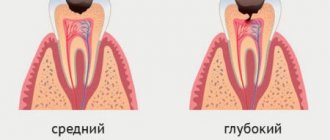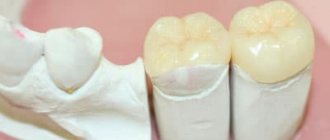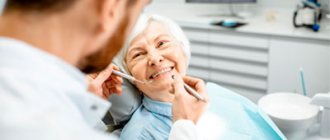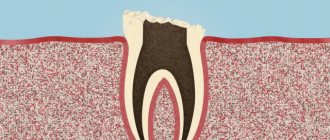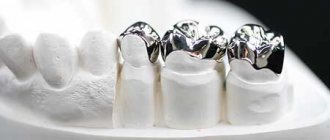Temporary filling.
What is a filling? This is a special composition that is used to fill damaged or prepared canals and voids in the tooth to prevent foreign substances from entering them.
There are several types of fillings in dentistry. Some of them are called temporary because they are installed at an intermediate stage of treatment. The main property of such a filling is that it can be easily removed. Accordingly, it is made from inexpensive materials so that the cost is affordable for any patient.
It is noteworthy that a temporary filling allows you to find a thorough approach to treatment in a short period of time. This happens when a person has deep caries. After all, if you immediately install a permanent structure, the boundary between the pulp chamber and the tooth tissues with the nerve bundle will become even thinner, and the process can develop into pulpitis. This leads to the need for root canal treatment, which is much longer and more difficult.
Process steps
When visiting a doctor, a thin gasket is installed, which must be removed after a strictly allotted time. At the same stage, the dentist should explain to the patient how long he can walk with a temporary filling. Installing such a gasket allows you to observe the tooth, and if it continues to hurt, then this is a sign that it is necessary to change tactics.
In case of pulpitis, a temporary filling is installed; only the dentist decides how long you can walk with it. Before making it, the doctor must open the tooth chamber and clean it thoroughly. Then medications containing arsenic are placed to relieve inflammation of the nerves in the dental chamber. This action also allows you to clean the canals painlessly.
If a patient has a toothache with a temporary filling and medicine, this indicates that the nerve bundle has not yet been killed. Typically, such a structure is removed a couple of days after installation. If the nerve is removed, then you can do without arsenic. However, before this, the dentist must remove all nerve bundles and treat the dental chamber with medication. The question of how long a temporary filling lasts is often of interest to many patients. If all the rules are followed, anyone can be sure that it will serve him for the necessary time until the doctor decides to remove it. As for eating, you are allowed to eat within a couple of hours after visiting the doctor.
Acute periodontitis
If a patient is diagnosed with acute periodontitis, he will have to visit the dentist more than once. During the first appointment, the doctor must examine the problem, take an x-ray and open the chamber of the tooth. It is also necessary to clean the channels inside it using antiseptic solutions. At home, the patient is required to rinse to remove all contaminants from the canals and dental chamber.
When you visit the doctor again, the canals are washed again, after which they are filled with medicine. And at this moment they put a filling. If you need a temporary filling, you can buy it at the pharmacy, but it is better to trust the doctor’s choice. When all the pain goes away, he can perform this procedure in your mouth.
Remember that a temporary filling is an important detail on which the entire treatment depends. Therefore, the doctor must select and install it himself.
Discomfort and inconvenience after installation of a filling
Immediately after a filling, the cause of discomfort in the mouth may be the lack of treatment before the filling is placed, and having a healthy tooth can create an unusual feeling of something new.
discomfort conditions of a filled tooth are a reason to urgently consult a doctor
- Foreign body sensation requires diagnosis to determine the origin of the discomfort. If you ignore such a symptom, there is a possibility of developing more complex inflammatory processes.
- A feeling of roughness and scratching indicates insufficient polishing of the filling. The defect is quickly eliminated with a second visit to the doctor and additional polishing to a comfortable state.
- An incorrect bite indicates an incorrect formation of the shape of the filling, which is measured in fractions of millimeters. The reason for this situation is the fact that anesthesia, which continues for some time after the filling procedure, does not make it possible to fully feel the shape of the tooth. Numbness of the jaw under the influence of anesthetics makes it difficult to report the presence of discomfort in the dentist’s office immediately after the filling is installed. The shape of the filling is quickly corrected by filing during a second visit to the doctor.
- A tightening tension in the jaw, a feeling of pressure inside the filled tooth, and discomfort when closing the teeth are created by an oversized filling. This is caused by increased pressure on the tooth walls and nerve endings. Possible consequences range from microdestruction of the dental wall to bacterial inflammation, from malocclusion to diseases of the temporomandibular joint.
- An incorrectly shaped filling can also create additional trauma to the oral mucosa when wearing orthopedic structures.
- Some time after the filling is installed, an increased reaction to irritants even without them (sour, cold, etc.) goes away with the correct selection of paste and other means. A sensitive reaction can be triggered by overdrying of the dentin during filling or loss of tightness of the filling material. To get rid of unpleasant sensations, the intervention of a doctor is necessary.
- Uncomfortable sensations during eating and the entry of food particles into the interdental spaces require the restoration of the interdental contact point, which determines the anatomical correspondence of the filled tooth with the rest of the teeth.
- An allergy to the components of the filling material is sometimes accompanied by bitterness in the mouth, pain, and skin reactions: itching, rash. In such a situation, the filling is replaced with a material that does not cause an individual reaction.
Dental specialists at Die Hard will individually consider the causes of discomfort after installing a filling and eliminate them, providing you with the comfort of healthy teeth. Dentistry in Moscow will cope with even the most complex inconveniences that appear after filling.
How long will such a unit last?
We have dealt with the question of why a temporary filling is placed, but many patients are interested in its service life. It can be several days or several weeks. This is due to the fact that different drugs are used while wearing it. If the patient feels that a tooth with a temporary filling hurts, then he will have to wear it longer than what was originally prescribed by the doctor.
Situations where product life varies:
- To kill the nerve, the seal is worn for about 3 days, and if perfume paste is used instead of arsenic, the period increases by 5-10 days.
- if the filling is used to treat deep caries with the help of antiseptics and antibiotics, then it is worn from 4 days to several weeks.
- in particularly advanced cases, such a filling can remain in a person’s mouth for 3 to 6 months.
If the patient cannot visit the doctor, then he must notify him in advance. Then the doctor will have to install a reflective durable filling, which will be worn for several months. As soon as a temporary filling falls out, you need to run to a specialist immediately, otherwise you will be in big trouble.
Life time
The service life of a temporary filling varies from 3-4 days to 2-3 weeks. The exact timing depends on the specific dental disease and the drugs used in treatment.
Here's how much a temporary filling can cost in different situations:
- when using arsenic paste to kill a diseased nerve - no more than 2-3 days (usually 24-28 hours), when using other means (for example, paraform paste) for the same purposes - 5-10 days;
- when using antibiotics and antiseptics in the treatment of deep caries or pulpitis - from 3-4 days to 2-3 weeks;
- in particularly complex diagnostic cases – up to 3 and even 6 months.
If you can’t get to the doctor on time, be sure to notify him in advance. In this case, if possible, he will try to place the most durable reflective filling that can be safely worn for several months.
Problems associated with installing a temporary filling
- Painful sensations. They can be caused by a poorly killed nerve, infection, or tissue inflammation. Sometimes patients experience allergic reactions, which can also lead to pain.
- The filling falls out or crumbles. In these situations, it is necessary to urgently consult your doctor. He will need another temporary filling; the patient should already know why it is placed. If this is not done, an infection may get inside the tooth chamber, which will lead to dire consequences.
- Having an unpleasant taste in the mouth. This is due to the fact that during the installation of the filling, medications with a pronounced aftertaste are used. When it is particularly strong, this may indicate that the structure is cracked. Therefore, it will never be a bad idea to see a doctor.
- Darkening of the filling or swelling of the gums are bad signs that require urgent medical intervention.
In order to avoid such problems, you must follow all the recommendations of a specialist. If you have a temporary filling, you should know very well how much you can’t eat, or you can ask your doctor. Therefore, under no circumstances should you eat food ahead of schedule. And under no circumstances should you pick apart a recently installed structure.
Possible complications after installing a temporary filling
Pathological processes or complications during treatment can arise due to an allergic reaction of the body, an incorrectly chosen treatment strategy, non-compliance with the period of wearing a temporary filling, or due to loss of medication.
- If the installation of a temporary filling was carried out after placing the drug in the tooth canal, pain may be a sign of an allergy, incorrect dosage of the drug, or incorrectly selected time of exposure. In case of allergies, the doctor replaces the cementing composition or medication.
- If the filling hurts when pressed, this indicates that the periodontal tissue is damaged.
- “Shooting” sharp pain is a sign of purulent pulpitis or tissue inflammation.
- If the pain occurs upon touching and is acute, there may be a piece of dental instrument left in the root canal. The cause of such sensations is also periodontitis.
- Night pain occurs with pulpitis.
Installation of a temporary filling is one of the stages of treatment, and not full-fledged therapy. Over time, such filling material falls out, food and microbes enter the tooth cavity, which leads to a worsening of the condition and the development of complications. In advanced cases, incomplete therapy can cause tooth loss.
Precautions to help you wear a temporary filling according to all the rules
How long a temporary filling can last depends on the patient. Therefore, in order to carry it for a long time, you must follow the following rules:
- Buy a brush with soft bristles. Teeth brushing is done twice a day. The use of mouth rinses is not prohibited.
- It is advisable not to chew gum or eat anything hard on the side where the filling is located. If a tooth itches under a temporary filling, this indicates that the nerve bundle is dying. You should not scratch your gums at this time.
- If pain occurs under the filling, rinse your mouth with tinctures of chamomile and sage; you can take painkillers as a drastic remedy. But you should stop using aspirin, because it is harmful to the stomach.
- A temporary filling is a treatment method that does not require many restrictions from the patient. If we talk about food, then you should take it no earlier than 2-3 hours after visiting the doctor. Because, unlike reflective fillings, temporary fillings take much longer to harden, and eating can deform them. You need to be patient for several hours so as not to regret the result later.
You need to know that a temporary filling cannot be installed at home. Because this procedure requires skills, experience and special equipment. Even after visiting dental clinics, sometimes it happens that the tooth under the temporary filling hurts, which requires visiting a doctor. It is advisable to choose only those clinics that have proven themselves positively and have a good reputation.
If you have a temporary filling that falls out, you don’t need to think about what to do, because you need to immediately go to the doctor. Only he will be able to eliminate all the consequences and install a new structure in accordance with the standards.
Visit the dentist on time, and then you will not have to treat your teeth for a long time. After all, prevention is an effective way to make your smile healthy.
-star /articles/vrem-plomba/» -star
AFTER THE TEMPORARY FILLINGS ARE INSTALLED, THE TEETH ITCH TERRIBLY, WE HAVE ALREADY REMOVED THE SECOND FILLING.
Good afternoon. My daughter is 5.5 years old. I saw caries on one tooth in the first milk painter after she complained of a second of pain when chewing. The pain was one-time and did not recur. We went to the dentist. I must say that this was the first visit, all the teeth were healthy before. He tapped the tooth, blew, and sprayed it—the child said it didn’t hurt. I looked at the hole and said it was deep, we will remove the nerve. The nerve was removed and a temporary filling was installed. We arrived home, after the anesthesia wore off, the child began to complain that his teeth were itching, namely his teeth and not his gums. But not a filled tooth, but 3 teeth located nearby. That is, as I understand it, the gums under the teeth itch. They itched to the point of tears, the child cried, grabbed a pillow or something hard and gnawed in order to somehow relieve these sensations. There was no pain, not when pressing, nor simply.
We called the hotline and said come and remove the filling. We arrived, drilled out the filling for us, and the itching immediately went away. They said that you probably had periodontitis, rinse for 3 days and then come back and we’ll put the temporary filling in again. They didn’t say what they put into the tooth and what they filled it with.
The next day I took the child to another clinic, the doctor looked at the tooth and said everything was fine, the tooth was clean, but you need to rinse it, come back in 2 days and I’ll put a filling. After 2 days (today) we came to the second doctor, because... Doubts arose about the professionalism of the former. He gave us a filling made of dentin paste and put a cotton wool with formaldehyde, resorcinol and iodine into the tooth. He warned that there might be some pain. While driving home, the child complained of pain. And at home my gums itched again even more than before. She grabbed the pillow, chewed it, roared. Then he says I won’t lie well. She gave me half a tablet of suprastin. It seemed to feel better at first, but after about 10 minutes it roared again - the teeth itched next to the sealed one. We returned to the doctor and pulled out the filling - everything went away instantly, nothing itched.
I have already called a dozen local doctors, someone suggests that it is an allergy to dentin paste and suggests covering the tooth with a cement filling. But if an itch appears after it, it will have to be drilled out. Tomorrow we'll go and try this option. If it doesn't help, I'm inclined to remove the tooth.
Maybe there are experienced dentists here who have encountered this in practice. What could it be. The tooth itself does not hurt at all, the only symptoms are terrible itching of three adjacent teeth after filling.
/detskii-stomatolog/view/983210/"
They treated me, but did not complete the treatment - the tooth under the filling itched.
When turning to the dentist, the patient expects that filling, removal of the nerve and the tooth itself, in case of emergency, will bring long-awaited relief and comfortable sensations in the oral cavity.
However, sometimes expectations are not fully met, for example, there is a strange feeling that the tooth under the filling is itching. The gums may or may not hurt, but the constant desire to “scratch the inside of the tooth” does not give rest. Why does this happen and what to do in such a situation?
Precautionary measures
In order not to bitterly regret the time spent in the dentist’s office, after installing a temporary filling, it is highly advisable to follow the following simple rules:
- When brushing your teeth, especially if the filling has been installed for a fairly long period of time, use a brush with soft bristles. Otherwise, oral care is carried out as usual: brushing 2 times a day, you can use rinses.
- Try not to chew on the affected side of your mouth, and temporarily avoid sticky toffees, chewing gum, hard nuts, bones and candy. Do not put pressure on the tooth while testing the strength of the filling.
- Within 1 day after installation, it is not advisable to eat beets, drink coffee, tea, or red wine, as the filling may become stained.
- Toothache will be relieved by rinsing with chamomile and sage decoctions, an aqueous solution with sea salt and soda. As for painkillers, it is better to consult a doctor. Aspirin should be avoided: it is ineffective against toothache, and in large quantities it harms the stomach.
- The most pressing question that arises after a temporary filling has been installed is: when can you eat? Modern reflective fillings harden almost instantly, meaning you can eat food within 20 minutes. But this is theoretical, but in practice it is better to clarify this point with the dentist. In most cases, you can safely eat and drink 2-3 hours after filling.
It is important to remember that the highest quality temporary filling is not a suitable replacement for a permanent one, so you should not delay your visit to the dental office.
Why does a tooth itch under a temporary (regular) filling?
In fact, teeth cannot itch in any way, since neither the dentin of which they are composed, nor the cement, nor the enamel covering the crown, have nerve receptors - these are hard tissues.
The itchy sensation in this case comes from the mucous membranes of the mouth and gums.
And the reasons for this phenomenon can be very different.
This symptom most often occurs due to the fact that temporary fillings are not airtight due to the characteristics of the filling material. But this is not necessary - it will soon have to be changed to a permanent one.
We will consider only individual factors that are the most common causes of dental itching that occurs after visiting the dentist's office.
Poor quality treatment
Unfortunately, this problem is no exception. Scratching a tooth can be a consequence of an infection acquired during root canal filling.
If dental treatment is carried out with violations of hygiene standards and technologies, inflammatory processes may develop in the oral cavity.
The most common complications are:
- gingivitis - inflammation of the mucous membrane of the gums;
- stomatitis - inflammation of the mucous epithelium lining the oral cavity;
- periodontal disease - severe inflammation of the gums, accompanied by the release of pus, loosening of teeth and pain;
- pulpitis is inflammation of the internal tissues of the tooth (pulp) due to infection.
If the patient had signs of candidiasis, manifested by white spots and plaque in the oral cavity, the use of certain types of antibiotics during a dental procedure could worsen local immunity and intensify the development of fungal infection. Thus, itching may be due to exposure to fungus.
Allergic reaction to dental medications
In some cases, the agents used in treatment may interact with bacteria inhabiting the oral cavity, resulting in an allergic reaction with symptoms of swelling.
A similar situation arises if metal structures in the form of crowns or prosthetic elements are placed on a filled tooth, which are incompatible with the gum tissue.
As a rule, products made from more expensive metals do not cause allergies, but in the case of using economy options, this is not excluded.
Allergic manifestations can also occur due to incorrectly chosen, inappropriate toothpaste, the components of which have an irritating effect on the mucous membranes. This type of allergy is easy to recognize if a person notices that itching in the mouth appears immediately after hygiene.
Other reasons
The gums between the teeth can itch for a number of other reasons:
- In young children, a similar condition may occur during teething, and may not be associated with a recently installed filling.
- Adult patients get this problem by not taking good care of their oral cavity and violating the rules of hygiene.
- Sometimes taking medications in the form of tablets or mixtures can change the acid balance on the surface of the mucous membranes or the composition of saliva, thereby causing discomfort. This reason also appears after some dental tests and studies.
- Lack of vitamins, especially vitamin C, can also affect the condition of the gums and provoke an itchy feeling in the mouth due to vitamin deficiency.
- Chronic stress causes dental itching of psychosomatic origin.
- Such an infrequent phenomenon as bruxism (jaw grinding at night) puts great stress on the teeth, exposing the gums and the neck of the crown, which can cause itching sensations.
- Often, children and adults experience microtraumas of the mucous membrane due to improper or rude hygiene. Because of this, wounds and erosions appear, which can lead to inflammatory processes and, accordingly, dental itching.
Thus, it is necessary to carefully analyze which cause in an individual case is the main one. And you can also detect the influence of a combination of factors. Therefore, it is still better to trust a good specialist.
Causes of tooth pain after filling
Pulpitis
The appearance of acute, spontaneous pain that grows and intensifies at night in a filled tooth may be due to the development of chronic or acute pulpitis. If such symptoms are detected, it is necessary to contact a dentist as soon as possible to remove a previously placed filling, remove the inflamed pulp, fill the root canals and the carious cavity itself.
Development of secondary caries
The source of pain in the tooth after filling can also be secondary caries, which gradually develops under the filling. The most common causes of this pathology are:
Causes of secondary caries
- insufficient disinfection of the carious surface before placing a filling;
- displacement of the installed filling under the influence of external factors;
- shrinkage of the filling material, which contributes to the formation of gaps between the filling and dental tissues;
- injury resulting in damage to the filling;
- irregular oral hygiene;
- violation of filling technology.
Treatment of secondary caries
When a secondary caries process is detected, the dentist removes the previously placed filling, cleans the resulting cavity from destroyed tissue, disinfects it and re-fills the tooth.
Underdrying or overdrying of the cavity
The causes of spontaneous pain that increases with biting in a treated tooth may be under-drying or over-drying of the tissues before filling. Before applying adhesive preparations, the surface dental tissues must be dried to a “wet sand” state (that is, the surface must remain wet, but there cannot be drops of water on it).
Consequences of overdrying tissues
Overdrying of dental tissues leads to damage to the nerve endings located in the surface layers of dentin. In turn, the death of nerve fibers can cause inflammatory damage to the pulp and other serious complications. Mild pain caused by overdrying of the carious cavity most often goes away on its own within 5-13 days. In situations where pain intensifies or persists for two weeks, patients are advised to return to the dental clinic for help.
Consequences of not drying the cavity
Failure to dry out the treated carious cavity can also cause pain. Drops of moisture prevent the penetration of adhesive preparations into the dentinal tubules, therefore, when the filling material shrinks, the composite easily comes off from the cavity floor, thereby forming pathological sinuses in the dental tissues. The only way out of this situation can be to replace the previously installed filling.
Granuloma or dental cyst
One of the likely causes of tooth pain after filling may be the formation of a granuloma (a localized area of inflamed tissue) or a root cyst (a pathological cavity in the gum tissue filled with bacteria, dead cells, blood and other physiological fluids). Granulomas and cysts are treated both conservatively (for example, using the depophoresis method) and through surgical intervention (cystectomy, hemisection, etc.).
Allergic reaction
In some cases, pain in a filled tooth can be the result of an allergic reaction to the components of the filling material. The clinical picture may be supplemented by urticaria, the appearance of an itchy rash and swelling on the patient’s skin and mucous membranes. If a patient is diagnosed with an allergy to the material used, the filling is immediately replaced.
Itching after tooth extraction
If the tooth could not be saved and it became necessary to remove it, gum damage occurs at the site of the operation. The wound, as a rule, heals on its own at home: it heals over time, and the gum surface is leveled.
Itching after tooth extraction may be associated with infection, in which case the following may occur:
- pain;
- edema;
- bleeding;
- impurities of pus;
- feverish conditions;
- deterioration in general health.
This happens if the doctor, after extracting the tooth, did not properly process the edges of the socket.
Other reasons for the appearance of itching after extraction include: a nerve was touched by the doctor during the operation, or there was an incompletely removed tooth bone.
What to do
Before you begin to get rid of dental itching, it is necessary to establish the exact cause of its occurrence, based on which methods for eliminating the unpleasant phenomenon are selected.
It is quite possible that if the tooth itches under the filling, it will have to be treated again, and you need to be prepared for this. In any case, you should definitely consult your doctor.
What you can do to get rid of annoying itching in your teeth:
- If you use an unfamiliar paste, change it to a proven one or follow the dentist’s recommendations when choosing a hygiene product.
- Replenish your diet with fruits and vegetables containing vitamin C to solve the problem of vitamin deficiency. Apples, lemons, orange juice, black currants, cabbage, and herbs will be useful in this case. You can take a course of vitamin therapy prescribed by a specialist.
- Get rid of the fungus by undergoing treatment with antifungal drugs.
- Take antihistamines if the cause is an allergy, then be sure to identify and eliminate the allergen.
- Analyze whether new foods have been introduced into the diet that provoked itching. Having identified them, remove them from the diet.
- Undergo a course of treatment with sedatives to normalize the neuropsychological state in case of itching due to stress.
- Do not panic if the tooth itches soon after removal, but wait a couple of days. The itching may disappear on its own, otherwise, contact your dentist. In addition, you can try to relieve the inflammatory process by rinsing with a chamomile decoction or a solution of soda and salt.
If the symptoms do not go away on their own, the dentist will select the necessary therapy. Can be assigned:
- Tests or scraping of plaque from the inflamed mucous membrane.
- Local preparations (rinses, gels, ointments).
- For more serious problems, antibiotics are prescribed.
- Candidiasis can be treated with a solution of methylene blue, Furacilin, diluted by Lugol, products with Clotrimazole, Nystatin, Fluconazole.
- For gingivitis and periodontal disease, tartar and plaque are removed and the oral cavity is treated with antiseptic ointments and solutions, and for acute pain, non-steroidal painkillers are indicated.
- For stomatitis due to herpes, Acyclovir in the form of ointments and tablets, Zovirax, Oxolinic ointment or immunoglobulins Anaferon and Viferon will be prescribed.
As phytotherapeutic agents, experts may recommend treating damaged membranes with sea buckthorn oil or using mouth baths made from decoctions of medicinal plants that have antiseptic and regenerating properties.
If, after installing a temporary or permanent filling, one-time itching in the teeth occurs, the following may be effective:
- rinsing the mouth with a saline-soda-iodine solution.
- chewing solid food.
- ice resorption.
For symptomatic treatment, the use of special sprays to relieve pain and itching is also effective.
This method can be recommended to parents of small children whose children do not yet know how to endure unpleasant itchy sensations.
But it is undesirable to abuse this method to avoid side effects.
Sprays for children can be replaced with the same sea buckthorn or tocopherol acetate solution, which can be used to treat the mucous membranes, using it for a longer period of time without consequences.
It is impossible to get rid of annoying itching in the teeth by scratching them from the inside, so you need to look for the cause and eliminate it. If the symptoms do not indicate anything, you should make an appointment with a specialist as soon as possible. He will examine the oral cavity and select effective treatment.
But it is worth noting that itching can also appear for no reason. Therefore, it is enough to observe for several days and if the symptom goes away and nothing bothers you anymore, then there is no need to worry. But if the itching remains or intensifies without subsiding for a long time, you need to seek help. This innocent symptom may indicate serious dental problems. Be healthy!
zubki2 /bolezni-zubov/plomby/cheshetsya-zub-pod-plomboy.html» zubki2
Why teeth may itch, cause and treatment methods.
It happens that an adult’s teeth itch, and he doesn’t really pay attention to it. Many people believe that this symptom cannot mean something bad, but in vain. Itching may indicate a serious illness. Therefore, doctors recommend that if any symptoms appear, you should go to the hospital.
Most often, itching occurs due to some dental disease. But it also happens that this symptom is the body’s reaction to an allergen. So, why do healthy teeth itch?
Itchy teeth - we need to identify the cause
Causes of tooth itching
Most people do not pay attention to such a symptom as itching in the teeth, but there are those who begin to worry about this. It is worth noting that teeth itch for various reasons. Sometimes it's really not a reason to worry. Therefore, if such a symptom appears, then you should just visit a doctor and find out whether there are any problems or not.
Itching is common with dentures.
Causes of itching in teeth:
- An allergy to any dental substances or toothpaste you use may cause itching in the area of your front teeth.
- Itching often occurs with dental ailments, such as periodontitis, gingivitis, stomatitis.
- Itching can occur due to thrush; many mothers may have observed a similar illness in their child. It manifests itself in the form of a white coating on the tongue, this is due to the fact that the protective functions of the baby’s body do not work well.
- Often a similar symptom manifests itself in adults who are constantly on diets. This occurs due to the fact that insufficient amounts of vitamin C and zinc enter the body.
- Itching can be caused by stress.
- The tooth may itch after filling the canals; this is the negligence of the doctor filling the canals, who did his job in bad faith. Also, a similar symptom appears during the eruption of wisdom teeth.
- Itching can occur with colds and viral diseases such as FLU, ARVI and acute respiratory infections.
These are the main reasons for the appearance of such an unpleasant symptom, but there may be others.
It happens that a pregnant woman or a small child’s front teeth begin to itch.
In the second case, the baby is 100% teething. But why teeth itch during pregnancy is not clear.
Why do teeth itch during pregnancy?
Every person knows very well that during pregnancy, cardinal changes occur in the female body. This is a natural biological process, because now the fair sex must monitor not only her own health, but also that of her unborn child.
Preliminary studies have shown that almost 50% of pregnant women experience toothaches that are not associated with anything.
No one previously understood why many girls experience itching and pain in their gums during pregnancy. But a logical explanation was still found. While carrying a child, the expectant mother's hormonal levels completely change, and the endocrine system begins to function differently. During pregnancy, the female body gains strength for future childbirth and because of this, problems with teeth, hair and even nails arise. This is because the expectant mother’s body does not receive enough vitamins and microelements.
Gingivitis is a cause of itching in pregnant women
Therefore, very often pregnant women go to the dental clinic with complaints that their teeth itch. And the cause of this symptom is often gingivitis. This disease most often progresses in the first trimester of pregnancy. This happens due to the fact that during this period the skeleton of the unborn child is formed. Therefore, all the vitamins that are necessary for bones are given to the baby.
If during pregnancy the gums between the teeth itch, this is the first symptom of gingivitis. Pain and swelling may also occur. During this disease, the teeth become very sensitive to cold and hot. Therefore, if you have identified one of the symptoms, you should urgently visit the dentist. Remember that all illnesses during a woman’s pregnancy directly affect the child.
Initial periodontal disease is always accompanied by itching
Why does itching occur after tooth extraction?
If your gums itch after tooth extraction, then don’t panic, wait a couple of days. If the itching does not go away after a while, then you need to consult a dentist. It often happens that after tooth extraction, the doctor did not properly treat the edges of the socket and because of this, the gums begin to itch.
There are also other reasons for itching after tooth extraction, including:
- During the operation, the doctor touched a nerve with an instrument, which caused an injury;
- did not completely remove the dental bone;
- infection in an open wound.
What to do in this situation? If there is an itching or unpleasant sensation at the site of tooth extraction, you should first visit a doctor. If this is not possible, then carefully examine the wound; it may be that an inflammatory process has begun. In this case, you can help yourself by rinsing, chamomile decoction or a solution of soda and salt. This will relieve some of the inflammation, but you should visit a doctor as soon as possible.
After three years of removing the nerve from the tooth, the tooth itches when the jaws touch
Ira, Moscow
282 views
November 29, 2020
Hello! Now I’m 25. After three years of removing the nerve from the tooth (bottom 7), the tooth (or the gum under it, to be more specific, if you poke a toothpick between teeth 7 and 6, then it’s from the outside where the cheek is, and not from sides of the tongue, you’ll feel something wrong and you’ll want to scratch it, but it didn’t bother me, it itched only when my jaws touched. One doctor said that it could be due to an incorrect bite and first put braces on my upper jaw. I was terribly sick for two weeks. Well, the problem, of course, did not disappear. When my jaws touched, it was still the same thing - scabies. But it didn’t worry me much, since I knew that I could not close my jaws for a while, I’ll be patient for two years and everything will pass. I’ve been walking for a month, everything is the same but the problem remains. Just yesterday they put braces on the lower jaw, and some kind of cement was applied to the upper chewing 6s (as the doctor explained to me, so that my teeth would not kill each other in the process of correcting the bite) which is just below these upper 6s. ok, and now even in a relaxed state (when the jaws are not closed at all), itching appears. It’s just that this unfortunate side with this insidious 7 doesn’t itch too much (considering, to my surprise, that the other side doesn’t bother me at all after installing braces on the lower jaw), and when the “cement” 6 is added to this feeling, there’s a general “shine” ", the scabies are still the same. When I close my jaws tightly, it is generally impossible not to fidget with my jaws, it itches terribly. Is it the fault of the bite? But there was no such problem before the nerve was removed. Before installing braces, they took an x-ray in a good clinic, they said there was no allergy to the material, there was no material left in the canal, the nerve was completely removed. What could this be? Will this nightmare be corrected in two years, when the braces are removed? Today I couldn’t sleep, even in a relaxed state, this cement comes into contact just a little with the tooth and it’s already itching... not strong, because the jaws don’t touch much, but itching. If it were due to the bite, then with not too much pressure there would probably be no scabies, considering that even in a calm state I touch a specific place (the gum between the lower 6th and 7th teeth and it is at the junction of these teeth that scabies occurs... if I poke a toothpick in the middle of the gum of the 7th tooth, where my nerve was removed, neither on the outside, where the cheek is, nor on the inside, where the tongue is, I won’t feel anything abnormal... only between the teeth on the outside
The question is closed
itching
tooth itch
contact of jaws
Itching under the filling
It happens that the tooth under the filling itches for no apparent reason; there may be several reasons. Most often, this indicates that he was treated poorly. If this is indeed the reason, then you need to carry out the procedure again. Itching may also occur due to an allergic reaction. Not all people are suitable for the drugs and materials used by dentists for dental treatment.
You should not try to get rid of the itching on your own. Indeed, in this case it occurs due to improper treatment. Only a dentist can help here, who will select individual and correct therapy.
There are situations when a tooth under a temporary filling itches; in this case, there is no need to panic. This symptom most often occurs due to the fact that temporary fillings are not installed tightly enough. After all, you still have to remove it and install it permanently.
Flux is the cause of itchy teeth
Why does a tooth hurt after installing a temporary filling?
Pain and discomfort can be a normal reaction, which occurs in 60% of patients, but sometimes pain indicates pathology, inflammation, and complications. After filling, you need to listen to your feelings; if your condition worsens, be sure to consult a doctor.
Installing a temporary filling may cause pain due to treatment and tooth preparation. Natural causes of pain:
- irritation, tooth trauma during cavity treatment, drug installation;
- the effect of medications on the dental pulp;
- the effect of necrotizing agents on the nerve, pulp until the death of nerve endings;
- increased tooth sensitivity, exposure to cold or hot food.
Temporary pain occurs in the first few days after treatment, it is short-lived, the intensity of the sensation gradually decreases, the tooth “aches”, but without excessively painful sensations. How long a tooth hurts after installing a temporary filling depends on the disease: during the treatment of caries it may not appear, but with pulpitis it goes away within one to two weeks. Dental gels and special pastes that reduce tooth sensitivity will help alleviate the condition.
Sometimes, under a temporary filling, severe tearing pain occurs, which intensifies at night. If such sensations are accompanied by other symptoms - swelling of the cheek or gums, numbness of the jaw, increased temperature, this indicates the development of complications. In this case, you need to consult a doctor as soon as possible.
What other causes of itching exist?
It often happens that your teeth itch, but it is very difficult to understand why. In addition to the main reasons, there are also a number of individual ones that do not occur so often. Therefore, if your tooth itches, consult a doctor for help.
There is such a pathology as bruxism, which occurs very rarely. It appears when there is heavy load on the teeth, the gums expose the neck and root of the tooth. In such a situation, only an experienced dentist can help. He selects special mouth guards that need to be worn only at night. This makes it possible to reduce the load on the teeth.
It also happens that people themselves are the culprits of their disease. Mucosal injuries can often occur in children and adults. This occurs due to the fact that a person performs oral hygiene incorrectly and rudely. Against this background, wounds and erosions appear, which can lead to inflammatory processes. Therefore, familiarize yourself with the rules of oral hygiene and choose only the right toothbrushes.
People often experience allergic reactions, which manifest themselves as itching in the teeth.
And this happens not from some dental products, but from some products. If you notice that after eating a product your teeth become itchy, you should remove it from your diet.
Temporary filling. What happens if you go with a temporary filling?
A temporary filling is placed on a tooth most often during root canal treatment (treatment of pulpitis or periodontitis - cysts). The main functions of a temporary filling are to isolate the medicinal material introduced into the root canals, prevent microbes and food particles from entering the tooth, temporarily restore the chewing function of the tooth, and strengthen the thinned walls of the tooth. The period for which a temporary filling is placed depends on what kind of medicine is in the root canals and what the initial diagnosis is. In some cases, the medicinal substance has strict restrictions on the period of application - for example, devitalizing pastes (arsenic analogues), which are injected into the tooth for 1-2 weeks in case of acute pulpitis, before removing the nerve and cleaning the root canals - in such cases, proceed with a temporary filling maybe a few days, a week at most. If you leave the devitalizing paste for a longer period, it will penetrate into the tissue surrounding the tooth and cause necrosis and inflammation of the periodontium - periodontitis.
If an antiseptic drug, for example, based on iodoform or calcium, is introduced into the root canals, then going with it is not so dangerous, but dentists still do not recommend leaving it for more than one month (in rare cases - three months), because when left in the canals for a long time, it dehydrates the hard tissues of the tooth, making the tooth more fragile. In addition, over time, the temporary filling may wear out, chip, lose its tightness (and the patient may not even notice it), while the medicinal substance will be washed out of the root canals, and an infection from the oral cavity will get inside the tooth, aggravating the problem (in this case, all Previous treatment and installation of a temporary filling will have to be repeated again).
If the root canals have already been filled with permanent material, and there is still a temporary filling on top, then it is also recommended to complete the treatment and restore the crown part of the tooth with a permanent filling, inlay or artificial crown within 1–3 months, because a dead tooth is very fragile, its walls can easily break off, the tooth can crack, and a temporary filling does not protect it from such situations. And if the temporary filling falls out or becomes leaky, then even microbes can leak into the root canals filled with permanent material, triggering the development of periodontitis (granulomas or cysts on the root of the tooth).
In any case, after installing a temporary filling, it is important to ask the dentist when it is necessary to continue treatment and clarify the maximum possible time for the temporary filling to remain in the tooth (in case of unforeseen circumstances and the impossibility of a visit on the appointed day).
Treatment of itching in teeth
You should not use medications to treat itching in teeth without a doctor's prescription. The wrong medicine can have a negative effect on the body. The treatment method is determined only by the doctor.
The most commonly used remedies to relieve itching are:
- If itching occurs due to allergies, then it is worth using antihistamines. But first you need to identify the allergen.
- People who suffer from psychological disorders are prescribed sedatives. After the person calms down, the itching will go away.
- For dental diseases, the doctor independently selects medications depending on the ailment.
Kalgel helps with itching


